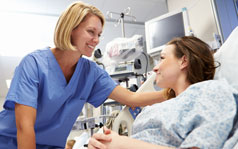Bunion Surgery
Contact Us
Request an AppointmentPlease note that a referral letter is required before an appointment can be confirmed.
Please note that a referral letter is required before an appointment can be confirmed.
Useful Information
About this service
A bunionectomy procedure removes the bunion and realigns the toe.
A bunion (hallux valgus) is a bony enlargement at the base of the big toe which can cause pain and discomfort. The primary risk factors for developing bunions include having a family history of the condition and being female, with women being nine times more likely to develop bunions than men. Wearing tight-fitting, confining shoes does not cause bunions, but can exacerbate existing bunion symptoms leading to increased pain and discomfort.
There are a number of non-surgical treatments for bunions including medication, orthotics or wearing comfortable footwear.
If non-surgical treatments are unsuccessful the surgeon may recommend a bunion surgery.
Before your surgery, you may need imaging tests. These may include X-rays, or magnetic resonance imaging (MRI).
It is important for patients to be in the best possible overall health prior to surgery.
Patients and their healthcare team can take several actions before and after surgery to reduce the risks of complications.
- Medication: patients should inform their surgeon of what medication they are on. The surgeon will review and decide if any of these need to be stopped before the procedure.
- Diet: in the weeks before surgery eat a balanced diet as this can help the healing process.
- Smoking: to reduce the risk of infection, patients who smoke will be asked to stop smoking for one month before and after the operation.
- Blood clots: to reduce the risk of developing a blood clot in the legs or lungs, a number of recommendations will be given to patients in advance of surgery.
- Infection: for patients who have signs or symptoms of an infection, such as a chest or urinary infection in the days prior to surgery, the surgeon should be informed. The surgeon will also need to be advised of a rash or flare-up of psoriasis or eczema around the hip area or a leg ulcer. For patients who have a history of MRSA/VRE or have been in contact with someone with MRSA/VRE, the Healthcare team should be informed.
- Exercise: it is important to be as fit as possible before the procedure, as it will make recovery much faster.
The surgeon and anaesthetist will discuss the options for anaesthesia with the patient, as well as the risks and benefits associated with each.
There are different types of bunion surgery depending on the severity of your bunion. These include the removal of the protruding bone or in more severe cases the bone can be broken and the toe realigned into the correct position. The surgeon will decide the type of surgery that suits a patient’s individual needs.
The majority of patients have this procedure as a day case and will return home the same day.
- After surgery, patients will stay in the recovery room or one to two hours before being discharged home.
- After the procedure the patient’s leg will likely be elevated to keep it from moving.
- It is to be expected that there will be some pain and discomfort after surgery. Patients will be given pain medication in hospital and will be sent home with a prescription for pain medication.
- Patients should organise for someone to drive them home from the hospital and stay with them for at least the first night.
- After their surgery, patients will likely need to wear a surgical foot or boot and use crutches for four to six weeks. Your surgeon will provide instructions about your recovery and rehabilitation.
- Patients will be given an appointment to attend the dressing clinic two weeks after surgery.
- Patients will be given an appointment to attend their surgeon four to six weeks post-op.
- Patients may typically require a follow-up x-ray.







.jpg?sfvrsn=6a6f32bf_1)


